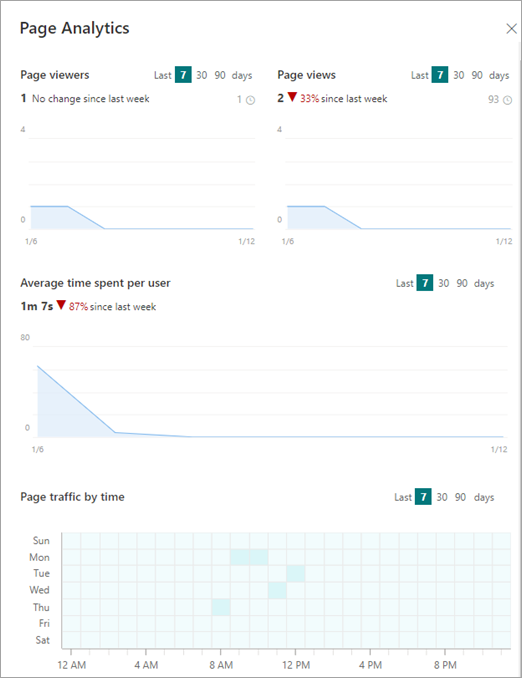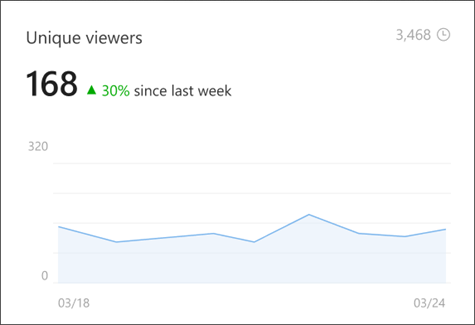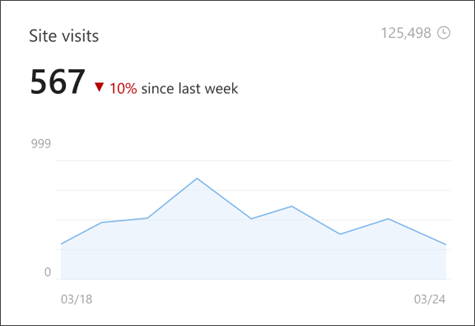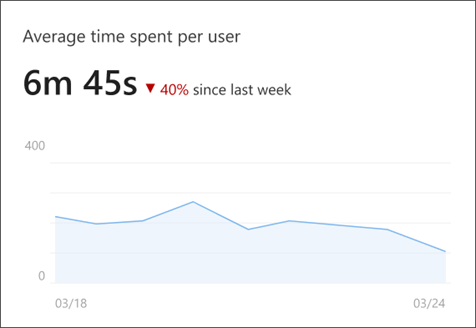With page analytics, you can view information about how users interact with your page or news post. For example, you can view the number of people who have viewed the page over periods of time, average time spent on the page spent per user, and page traffic by time.
If you are a page owner or member of the site where the page resides, you can view analytics for your page or news post by selecting Analytics at the top of the page.
Visitors of the site can view analytics by selecting Views at the bottom of the page.
Notes:
-
Lifetime stats are shown for pages created after February 2018. Sites created before this date will show stats from February 2018 forward.
-
Usage data is aggregated and displayed based on Coordinated Universal Time (UTC).
-
Guest users will not have access to site analytics or site usage data.
-
Guest and anonymous views and visits are included for sites creating after after March 2019.
-
Usage data for Page viewers, Page views, and Average time spent per user is aggregated and displayed based on Coordinated Universal Time (UTC).

Page viewers
Shows the total number of individual visitors to the page, regardless of how often they've visited.
You can review daily unique viewer trends on your site for the last 7 days, last 30 days, and last 90 days. The overall unique viewer count is available for the last 7 days and the last 30 days. This data is presented using the Coordinated Universal Time (UTC).
In the example below, the 7 day view for this site tells us there have been 168 unique views which is a 30% increase in traffic from last week. On the right-hand side of the graph, you'll see the lifetime unique viewers which is the total number of people who viewed content on this site since February 2018 and in this example is 3,468.

Page views
Shows the total number of page views for the last 7 days, last 30 days, and last 90 days. This data is presented using the Coordinated Universal Time (UTC).
The algorithm used to calculate page views is designed to filter out repetitive, continual operations by the same user on the same item, such as when a user repeatedly refreshes the page.
In the example below, the 7 day view for this site tells us there have been 567 site visits which is a 10% decrease in traffic from last week. On the right hand side of the graph, you'll see the lifetime site visits which is the total number of people who viewed content on this site since February 2018 and in this example is 125,498.

Average time spent per user
Note: A small amount of traffic will not be accounted for in this report due to web browser restrictions.
Shows the trend of actual time spent on pages and news posts by users. The report calculates the time spent when users are active on the page or news post. The average count for 7 and 30-day period is calculated by measuring the total time spent on that page and the number of the unique visitors on that page in the given timeframe. This data is presented using the Coordinated Universal Time (UTC).
Usage on the SharePoint mobile app is currently not incorporated in calculation of this report.
In the example below, the 7 day view for this page tells us average user spends 6 minutes and 45 seconds actively engaged with the page which is a 40% decrease from last week. There is no lifetime average time spent per user metric.

Page traffic
Shows the hourly trend of visits to the page over the last 7 days, last 30 days, and last 90 days for the viewer's local time zone. Darker shades on the chart refer to time slots when there are more views. Use this map to determine to best time to post news and big announcements.
Get usage data for a SharePoint site
As a SharePoint in Microsoft 365 site owner, you can view information about how users interact with your site. For example, you can view the number of people who have visited the site, how many times people have visited the site, and a list of files that have received the most views. Learn more.










